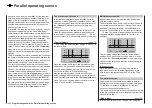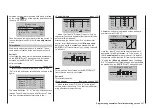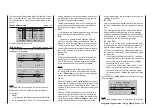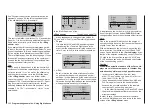
296 Programming examples - Parallel operating servos
Parallel operating servos
A second servo running in parallel is often required,
such as when brake flaps or spoilers installed in the
wings or the left and right elevator or a double fin
should be actuated by a servo or a large rudder flap
should be simultaneously controlled by two servos
due to high throw forces.
In principle, this task could also be solved by connec-
ting the servos together on the model side using Y-
cable. However, the disadvantage here is that servos
combined in this manner can no longer be adjusted
individually and separately from the transmitter – thus
negating the potential for finely tuning respective
servos to one another with a computerized remote
control system. A similar situation is given for the so-
called “Channel mapping” feature of the »Telemetry«
menu. Here too there are certain limitations involved
when compared to the transmitter’s adjustment pos-
sibilities.
The first example, therefore, describes the coupling of
two brake or spoiler servos, the second describes the
operation of two or more throttle servos and the third
describes the coupling of two elevator servos.
The “two rudder servos” example on the next page
describes the coupling of two rudder servos, whereas
Variant 1 is preferable for applications of this type
because this solution is easier and quicker to pro-
gram, using one of the »Dual mixer« menu, which is
available as standard on the
mc-20
HoTT transmit-
ter only, but which can be unlocked on the
mc-16
HoTT transmitter as an extra-cost option. In contrast,
the second variant, also described on the next page,
additionally permits asymmetric and/or non-linear
curves through use of the »Free mixer« menu.
Two brake or spoiler servos
In a situation where there is one installed servo for
operation of brake flaps and/or spoilers in each wing
half then the pre-set linear control characteristics for
the »Channel 1 curve« menu should remain un-
changed.
Then connect one of the two servos to Output 1, pro-
vided for this purpose by standard, and the second
to an arbitrary free receiver connection 5 … 12 max.,
such as Output “8”. Subsequently switch to the menu
…
»Control adjust«
… and, using the selection keys, assign “Control 1” in
the Input 8 line :
In5
offset
0%
0%
0%
–––
In6
In7
In8
–––
–––
–––
GL
GL
GL
typ
fr
fr
fr
Cn1
SEL
GL
0%
Since the spoiler on Output 1 can normally only be
operated on a flight-phase independent basis, it is
strongly recommended that the “Typ” column for the
input used is left at its “GL” default setting.
Also the remaining values should be left at their
default settings. If necessary, carry out the required
servo travel adjustments in the »Servo adjustment«
menu. There you can also adjust the travel of servo
1 and 8 to one another, if necessary.
Multiple-motor aircraft
As described above, a model can also be operated
with two or more motors.
The first throttle servo and/or the first motor control is
connected as usual to (receiver) Output 1 and each
additional throttle servo and/or each additional mo-
tor control is connected to a free (receiver) Output 6
… 12 max. The inputs of respective assigned control
channels are then each assigned to Control 1; for
example:
In8
offset
0%
0%
0%
–––
In9
In10
In11
–––
–––
–––
GL
GL
GL
typ
Cn1
SEL
GL
0%
Cn1
Cn1
Cn1
The remaining values should be left at the default
settings. If you need to adjust servo travels, it is bet-
ter to use the »Servo adjustment« menu, where you
can adjust the settings as required without having to
switch menus.
Important notice:
Since the motor control unit should be available
regardless of a currently active flight phase, make
sure to leave the standard default “GL” in the “Type”
column.
Two elevator servos
Two elevator servos should be switched in parallel.
According to the receiver assignment plan, see page
73, the receiver output 8 is intended for the con-
nection of the second elevator servo.
This would be taken into account on the software side
in the pre-configuration of a corresponding mixer. You
can find this in the …
»Model type«
In this menu, switch to the “Tail type” line using the
Summary of Contents for HoTT MC-16 Series
Page 1: ...Programming Manual mc 16 mc 20 HoTT 1 en mc 16 mc 20...
Page 27: ...27 For your notes...
Page 53: ...53 For your notes...
Page 61: ...61 For your notes...
Page 65: ...65 For your notes...
Page 71: ...71 For your notes...
Page 103: ...103 For your notes...
Page 107: ...107 For your notes...
Page 111: ...111 For your notes...
Page 155: ...155 For your notes...
Page 165: ...165 For your notes...
Page 201: ...201 For your notes...
Page 229: ...229 For your notes...
Page 231: ...231 For your notes...
Page 261: ...261 For your notes...
Page 265: ...265 For your notes...
Page 301: ...301 For your notes...
Page 327: ...327 For your notes...
Page 328: ...328 For your notes...
















































